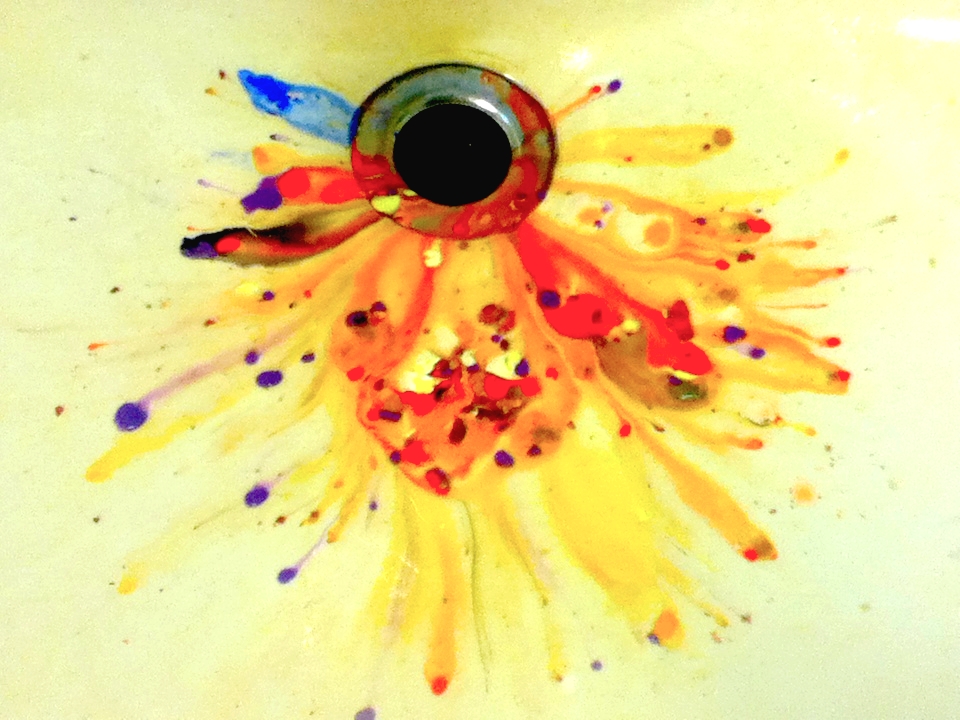
Wet paint wrinkles up thin pages like the skin of an aging woman. A quick stroke of coral forms a sagging smile. Form the strong cheekbones and knowing eyes and you have Marilee, a God-fearing woman with an opinion a little too loud. Paint her brokenhearted in a wheelchair by the warped windowpane. Paint the sunrise low on an early September wheat field in marigold, apricot, and burnt sienna. Dip the tip in water and give it a shake before adding midnight blue. If you are careful in your strokes, by the time you reach the bottom the blue will fade to white and you can add clouds of copper and orchid just above the stream. Don’t forget to add the willow Marilee planted forty years ago at her now absent husband’s side. You would climb that tree, young and careless, in a summer skirt and your Tuesday underpants on a Friday. Lick the brush tip and dip it in peridot to get the perfect color for the willow’s wispy leaves. You can’t paint the cicada’s song, but know it is there. Last, paint yourself in a lime and daffodil dress in a chair opposite your grandmother.
The paint will soon dry. Sketch in the next year quickly. Drag the brush over Marilee’s lonely brows and give her the wrinkles you used to feel with your fingertips. Highlight the longing in her eyes with the white you used to pepper her hair. Paint her paper-thin hands as she writes her goodbye letter to us and her hello letter to the love of her life. She would hold him tomorrow and you in a lifetime. Spill a tear on the page and smudge it away as you remember the night before as she held you in her lap and spoke to you, almost too soft to understand, “Thanks for being such a great-granddaughter.” Wipe another when you remember how little you knew of her soul. Press the tip of your brush to the page and leave it there, watching the edge of the pigment spread towards the image of you and her clinging to each other on the edge of everything, and hang it up to dry once the water spreads to her cold hands the next day.
Grab a new sheet and scrape your pallet. The old acrylic has dried up. Mix a gold and a scarlet and leave white and yellow plain at the edge. Form a best friend from youthful, quick strokes of peach and blue. Grab the widest brush you have, dip it in a jar of water, now soupy grey, before swiping it through the pool of manila. Drag the brush along the page, twisting your wrist to form a sandy path. The sky was timberwolf grey, but you mix aquamarine instead because you feel like it. Use maroon and white for the polyester tracksuits and paint your friend running, sweaty and tired, at your side. Paint her here with you now too, not because she is but because you wish she were. Paint your eyes when they told you, and paint her eyes in yours. Sculpt the peaks and valleys of the flames as they caress her cheeks, her arms, her everything, and paint the man who went back for her and never returned. Use up the gold and scarlet, and touch the page slightly with the plain white, yellow, and black. Start to add yourself carrying her frail body out in your burnt arms, but smudge the lie because you know you were a few miles away, warm in bed.
Finish up by starting the knowing lines around your eyes—eyes that are wet and starting to look like Marilee’s. Place this sheet on the rack with the first. Your hand is cramping, but you grab a new sheet. Imagine the warmth of the sun as you paint it on your face and hers— Aunt Ida. You look just like her, so you can use the same faded peach as you used for yourself. Paint your smile like hers looked twenty years before, and use the Superior blue from her eyes on your mother’s younger ones. Give her the widest smile of all, and let her hold the wheel and steer. Sing “The Night Chicago Died” and trace the long, greying strands of Ida’s hair. Decide not to paint her in the hospital bed, and scrap the plum and charcoal you mixed for her bruises. Blot out the memory of the man who took her heart and life, and start fluffing the clouds and fresh highway through the windshield. Forget the next two years and ignore the image of your mother’s broken heart. Add more lines around your eyes, though, and keep singing “500 Miles.”
You started, young and naïve, with your hands in the cool, vibrant puddle and slapped them onto chartreuse construction paper. You raised your hand to ask teacher for help printing your name and smiled when you handed the prints to mom. Grin from ear to ear every time you see it on the refrigerator, next to faded and fresh photos of those loved, lost, and found. Eventually, discover your fingertips. Dip one at a time into a different color: cerulean, maize, thistle, and sienna. Get lost in the smooth, pre-mixed tempera colors. Smear them on the page until the smudges look like mom. Wrinkle your soft forehead in confusion when mom takes down the handprints, but feel your cheeks burn with pride as she puts up your new, finest work. Eventually, find your fine motor skills and wrap your middle, thumb, and forefingers around a thin brush. Close your eyes and fall in love with the smell of acrylic. Close your eyes and revel in your memories. Open them, pull the sultry scent of stain into your lungs. Mix mango, sunglow, and cornflower blue. Lay out a bright fresh piece of canvas, feel the pleasant rays warming your cheeks, and prepare to paint the rest.
 Hayli M. Cox is a teaching assistant and creative writing MA candidate at Northern Michigan University, where she obsesses over literature, zoology, wine, and over-steeped tea on the shores of Lake Superior as her pet rats crawl across her keyboard. Her first four publications appeared in The Lightkeeper and Haiku Journal. She practices technical writing for a living and creative writing for a life.
Hayli M. Cox is a teaching assistant and creative writing MA candidate at Northern Michigan University, where she obsesses over literature, zoology, wine, and over-steeped tea on the shores of Lake Superior as her pet rats crawl across her keyboard. Her first four publications appeared in The Lightkeeper and Haiku Journal. She practices technical writing for a living and creative writing for a life.


Gorgeous rendering of love, loss, and the colors of life.
Hayli, this is magical. It’s poetry. Your visuals are stunning. I’ve never read anything quite like it. What a pleasure. I look forward to reading more from you.
I’m so glad you enjoyed it! I don’t think I’ve ever had more fun writing a piece. Thank you for taking the time to comment such kind words!
Beautiful piece!
Why, thank you!